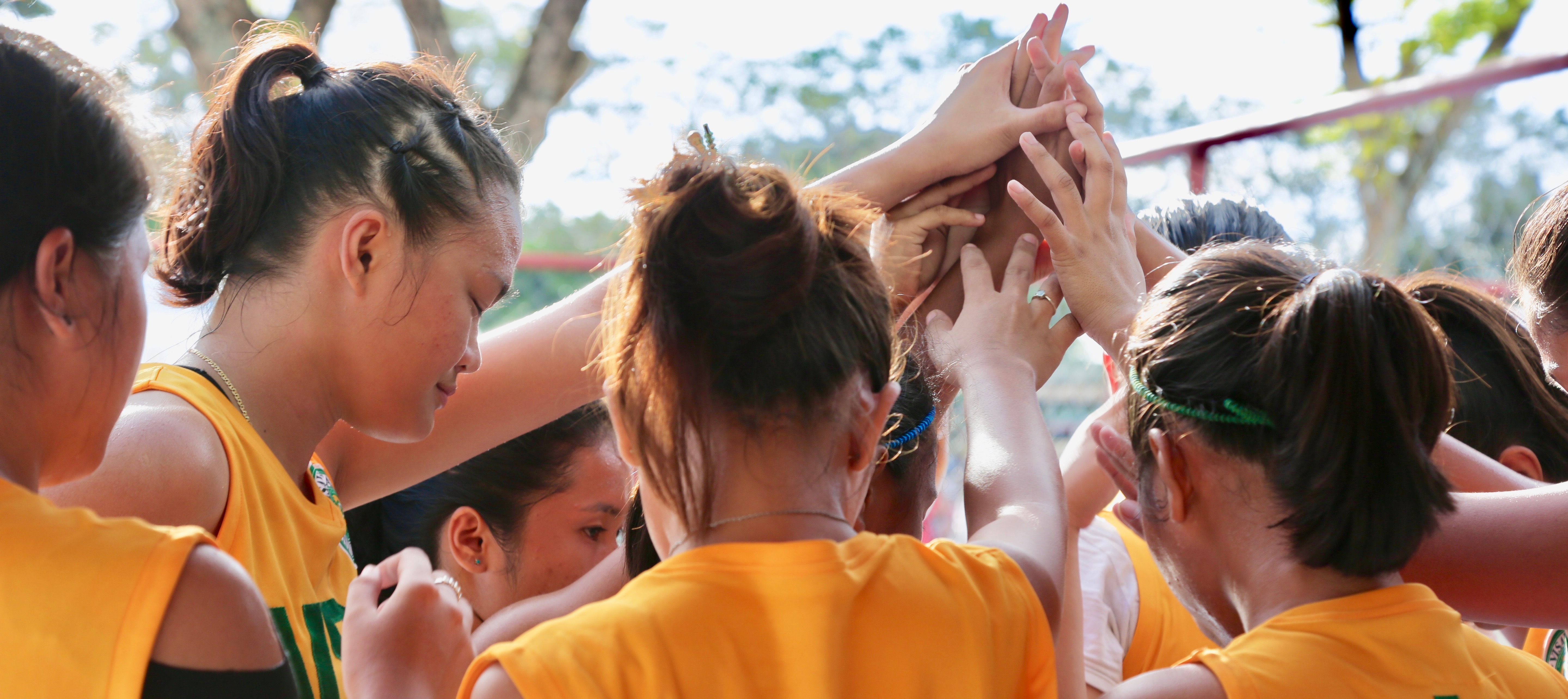Informational
Accredited Student Organizations
|
||
COURSE-RELATED |
ADVISER/S |
PRESIDENT |
|
ABELSS (English Language Students Society |
Dr. Jett C. Quebec |
Bernadeth P. Pepito |
|
Dr. Cherry N. Rola |
||
|
AMA (Agronomy Majors Association) |
Dr. Luz G. Asia |
Ivy D. Dagumay |
|
Ms. Gweneth M. Abit |
||
|
APBM (Association of Plant Breeding Majors) |
Ms. Jedi Joy B. Mahilum |
Carlo B. Bestorillo |
|
Ms. Julien R. Deroy |
||
|
BPEd SS (Bachelor of Physical Educa Student Society) |
Ms. Florife A. Gatchalian |
Christopher M. Gonzales |
|
Mr. Lyndon L. Maningo |
||
|
ChemSoc (Chemical Society) |
Dr. Elizabeth S. Quevedo |
Jotham Lloyd Alegre |
|
Mr. Kevin Nick S. Bandibas |
||
|
CSSS (Computer Science Students Society) |
Mr. Eugene Val Mangaoang |
Christian A. Bandibas |
|
Mr. Jomari Joseph A. Barrera |
||
|
DeCSo (Development Communicators' Society) |
Ms. Mae Claudine M. Gica |
Margraf Von Sean G. Eslopor |
|
Mr. Jed Asaph D. Cortes |
||
|
FSS (Forestry Student Society) |
Dr. Renelita Come |
Romeo T. Dequito, Jr. |
|
Prof. Anatolio N. Polinar |
||
|
GEP (Geodetic Engineers of the Phil-VSU Chapter) |
Engr Diana Christa G. Milloza |
Mark Gil D. Cabangal |
|
Engr. Rex R. Doñoz |
||
|
HOMES (Helpers In Outreaching Mother Earth's Stability |
Dr. Marlito Jose M. Bande |
Marrian Mae N. Pepito |
|
Interact Society |
Marilyn N. Manaig |
Joshua B. Casinillo |
|
Jay C. Bansale |
||
|
JPSME (Junior Philippine Society of Mechanical Engineers) |
Engr. Philip Caesar Ebit |
JB Lord B. Amith |
|
Engr. Vic Angelo Impas |
||
|
KaFiM (Kapisanan ng mga Filipino Majors) |
Dr. Rizalina D. Truya |
May D. Apepe |
|
Ms. Marievic S. Flores |
||
|
LExES (League of Exemplary English Students) |
Ms. Marilyn N. Manaig |
Nikita Aisle M. Rosal |
|
Ms. Louisa Marie B. Andrade |
||
|
LeSciM (League of Science Majors) |
Dr. Lijueraj J. Cuadra |
Ella Marie G. Nuñez |
|
Dr. Christy M. Desades |
||
|
MMS (Math Majors Society |
Dr. Eusebio R. Lina, Jr. |
Jenalyn D. Ambi |
|
Dr. Ma. Rachel Kim Aure |
||
|
Mentors' Guild |
Ms. Louisa Marie B. Andrade |
Kyla Mae Batestil |
|
Ms. Crisyl S. Compendio |
||
|
OBioS (Organization of Biology Students) |
Ms. Fretzeljane D. Pogado |
Karen C. Nava |
|
Mr. Kenneth O. Eco |
||
|
OSSM (Organization of Soil Science Majors) |
Mr. Medardo Magdadaro, Jr |
Ezra G. Monte |
|
Mr. Kenneth Oraiz |
||
|
PAFT-KSC (Philippine Association of Food Technologists-Kappa Students Chapter) |
Dr. Lynette C. Cimafranca |
Angela Mea R. Reusora |
|
Engr. Julious B. Cerna |
||
|
PICE-VSU SC (Philippine Institute of Civil Engineers-VSU Student Chapter) |
Engr. Hanzel N. Mejia |
Joseph Napoles |
|
Engr. Jan Joshua M. Pomida |
||
|
PPMA (Plant Protection Majors Association ) |
Dr. Reny G, Gerona |
Judy Ann Jane B. Crave |
|
Dr. Mary Joy M. Abit |
||
|
PSABE-VSUSC (Philippine Society of Agricultural & Biosystems Engineers) |
Engr. Arthur IT Tambong |
Joshua Emmanuel B. Tismo |
|
Engr. Triana D. Soroño |
||
|
Engr. Jessie James D. Layan |
||
|
SABS (Society of Agri-Business Students) |
Mr. Bryan R. Gapasin |
Valentin F. Sabando |
|
Mr Bert Peñalosa |
||
|
Ms. Loregin S. Pugosa |
||
|
SASS (Society of Animal Science Students) |
Ms. Rosa De Lima G. Beato |
Rodel M. Batindaan |
|
Mr. Roger Roque E. Bustamante |
||
|
SHoTS (Society of Hospitality & Tourism Students) |
Ms. Hannah Mae E. Quimbo |
Colleen Kaye Negad |
|
Ms. Syrene P. Nayre |
||
|
TORAH |
Mr. Randy G. Omega |
Cristille M. Madera |
|
Ms. April Gail N. Valencia |
||
|
ViHoS (Visca Horticultural Society) |
Dr. Santos B . Villocino, Jr. |
Jessica S. Majerano |
|
Dr. Catherine C. Arradaza |
||
|
VSU-AgExSo (VSU Agricultural Extension Society) |
Mr. Virgelio C. Dargantes |
Jesie Pepe L. Bartolome |
|
Ms. Rosemarie B. gonzaga |
||
|
VSU-BS (VSU Biotechnological Society) |
Mr. Ronald Arlet P Villaber |
Rey Christian S. Bitor |
|
Ms. Chloris Marie E. Caseres |
||
|
VSU Meteorological Society |
Mr. Charlindo S. Torrion |
Leanne Marie A. Loreto |
|
VSU-SS (VSU Statistical Society) |
Ms. May Ann E. Palen |
Rose Ann N. Bartido |
|
Ms. Donna C. Cuyno |
||
|
YES (Young Economists Society) |
Ms. Maria Hazel I. Billezas |
Neca Jane O. Malacora |
|
Prof. Ernesto F. Bulayog |
||
GREEK-LETTERED ORG |
ADVISER/S |
PRESIDENT |
|
Adamas Nu Omega |
Mr. Dioscoro M. Bolatete, Jr |
Jeric M. Almeroda |
|
Ms. Lisa I. Arce |
||
|
Alpha Phi Omega |
Engr. Marlon Burlas |
Rowena Senerdida |
|
Ms. Lovella Tambis |
||
|
Gamma Epsilon |
Mr. Buen Josef Andrade |
Joni Franz P. Davis |
|
Gamma Sigma Confraternity |
Pamela H. Urdaneta |
John Rey Latras |
|
Sigma Alpha Epsilon |
||
|
Tau Gamma Phi |
Dominic Michael Garrido |
Joselito Aya-ay |
|
Tau Omega Mu Fraternity & the Ladies Circle |
Mr. Marcho P. Bandalan |
Edmond L. Reyes |
|
Ms. Paula Nadrea M. Paquibulan |
||
|
VKV-VLV (Venerable Knights Veterinarian Fraternity-Venerable Ladies Veterinarian Sorority) |
Dr. Santiago T. Peña, Jr. |
Serville O. Abueva |
|
Dr. Carl Leonard M. Pradera |
||
INTEREST GROUPS |
ADVISER/S |
PRESIDENT |
|
Association of Rodeo Enthusiasts (AREV ) |
Dr. Julius V. Abela |
Patt Joshua C. Andrade |
|
Mr. Michael Dominic M. Garrido |
||
|
Banaag Visual Arts Group |
Mr. Mizael B. Cerna |
Cherry Bea V. Jumawan |
|
Mr. Lolito D. Caña |
||
|
Dog Owners' Club (DOC) |
Dr.Melvin A. Bagot |
Kirk Michael C. Caniga |
|
Dr. Kenny Olana |
||
|
DOST-SS (DOST Scholars Society) |
Engr. Rex R. Doñoz |
Mary Michelle A. Tesado |
|
Engr. Diana Christa G. Milloza |
||
|
TARSIER (Terrestrial & Aquatic Restoration by Students Immersed in Environmental Reforms) |
Mr. Charlindo S. Torrion |
Krystel Denise L. Labrador |
|
Engr. Hanzel N. Mejia |
||
|
Ms. Mary Annilyn Villar |
||
|
UISB ( University Inter-Dormitory Student Body) |
Ms. Mae Claudine M. Gica |
Kurt Jose Daniel Ceniza |
|
Mr. Ramil B. Vinculado, Jr. |
||
|
Engr. Hanzel N. Mejia |
||
|
VSU Debate Society |
Dr. Jett C. Quebec |
Ann Melene C. Fernandico |
|
Mr. Beljun P. Enaya |
||
|
VSU Robotics |
Engr. Philip Ceasar Ebit |
Lesley Angel C. Radores |
|
Mr. Michael Anthony Jay B. Regis |
||
|
VSU Ultimate Frisbee Club |
Mr. Edilberto A. Artiga Jr. |
Lloyd V. Cedro |
REGIONAL GROUPS |
ADVISER/S |
PRESIDENT |
|
HI (Hugpong Ilonggo) |
Ms. Angelita L. Paradero |
Geraldine B. Daganasol |
RELIGIOUS GROUP |
ADVISER/S |
PRESIDENT |
|
AC (Ambassadors for Christ) |
Prof. Lorina A. Galvez |
Zev L. Oliveros |
|
Mr. Kenneth Oraiz |
||
|
AMiCUS (Adventist Ministry to College and University Students) |
Engr. Hazel N. Mejia |
Jemboy D. Hermo |
|
Mr. Edralin M. Malasaga |
||
|
CBI (Christian Brotherhood International) |
Mr. Jeremias Vista |
Jawrence Benz Casupang |
|
Dr. Renezita S. Come |
||
|
Ikthus Campus Care |
Prof. Elsie E. Salamat |
Pam P. Escopete |
|
Ms. Geraldine T. Baro |
||
|
LA (Lakas Angkan Undergraduate Ministries) |
Ms. Inish Chris P. Mesias |
Argie D. Dadis |
|
Ms. Shalom Grace Sugano |
||
|
LDSSA (Latter Day Saints Students Association) |
Ms. Ma. Fe L. Gayanilo |
Aldrin G. Basmillo |
|
SPARKS (Students Proclaiming A Righteous King & Savior) |
Ms. Emily L. Casinillo |
Mark Angelo D. Menorias |
|
Mr. Rommel M. Garrido, Jr |
||
|
Students LinC (Student Leaders in Campus) |
Mr. Jaime B. Berundo |
|
|
Students of Destiny |
Dr. Nilda T. Amestoso |
Dixie Grace A. Gelaga |
|
The Builders |
Dr. Santiago T. Peña |
Van Adrian E. Mazo |
|
Ms. Mary Cris F. Pleños |
||
STUDENT COUNCIL |
ADVISER/S |
PRESIDENT |
|
USSC (University Supreme Student Council) |
Dr. Guiraldo C. Fernandez, Jr. |
Chad Christian D. Wales |
|
Prof. Ernesto F. Bulayog |
||
|
Mr. Raymund M. Igcasama |
||
|
CAFS-SSC (College of Agriculture & Food Sciences Supreme Student Council) |
Dr. Julius V. Abela |
Diana Rose R. Lasconia |
|
Mr. Kenneth Oraiz |
||
|
CAS-SSC (College of Arts & Sciences Supreme Student Council) |
Mr. Raymund M. Igcasama |
Jeremiah D. Laude |
|
Ms. Eunice Kenee L. Seriño |
||
|
CoEd-SSC (College of Education Supreme Student Council) |
Ms. Crisyl S. Compendio |
Jodel M. Navera |
|
Mr. Edilberto A. Artiga, Jr. |
||
|
CFES-SSC (College of Forestry & Environmental Sciences Supreme Student Council) |
Dr. Dennis P. Peque |
Aliah A. Bacus |
|
Dr. Angelica P. Baldos |
||
|
CME-SSC (College of Management & Economics Supreme Student Council)) |
Dr. Nilda T. Amestoso |
Aubrey Maekaela G. De Asis |
|
Mr. Randy G. Omega |
||
|
Mr. Karl John A. Galvez |
||
|
CET-SSC (College of Engineering & Technology) Supreme Student Council) |
Engr. Christa G. Milloza |
John Allan A. Gulles |
|
Engr Jessie James D. Layan |
||
|
CN-SSC (College of Nursing Supreme Student Council) |
Ms. Jesusa M. Magno |
Lance M. Morquianos |
|
Mr. France Allan Cavite |
||
|
CVM-SSC College of Veterinary Medicine Supreme Student Council) |
Dr. Agnes M. Taveros |
Tisha Marie L. Cortez |
|
Dr. Jane P. Duatil |
||
Here at VSU, we aim to provide quality service to our students by engaging them in an active learning environment centered on their success. This is one with our goal to produce highly competent, quality and world-class manpower in science and technology, especially in agriculture, environmental management and industry who are proficient in communication skills, critical thinking, and analytical abilities.
Attributes of a VSU Graduate
- Competence
- Graduates possess relevant knowledge, skills, and attitudes needed in their chosen fields, and can apply these in the practice of their profession and in giving service to the community.
- Resilience and Endurance
- Graduates are flexible, adaptable, and steadfast when facing challenging life situations.
- Critical Thinking Skills
- Graduates are reflective and can critically analyze and evaluate facts, observations, and differing opinions to arrive at a sound judgment or conclusion.
- Effective Communication Skills
- Graduates can communicate information and ideas effectively and express needs and opinions clearly to varied audiences.
- Leadership Skills
- Graduates act professionally, and ethically, and can assume effective leadership roles in their chosen careers and in society.

• College Admission Test
Become a full-pledged Viscan and take the VSUCAT. Check the examination schedule and requirements here.
• Scholarship
Find the right grant that suits your needs.

• Student Services Office
The University Student Services Office (USSO) is ready to assist you with our welfare and development services/programs tailored to meet your student needs.
• Student Housing
Choose where to spend your college days while on campus. Stay near Mt. Pangasugan or by the Camotes Sea.
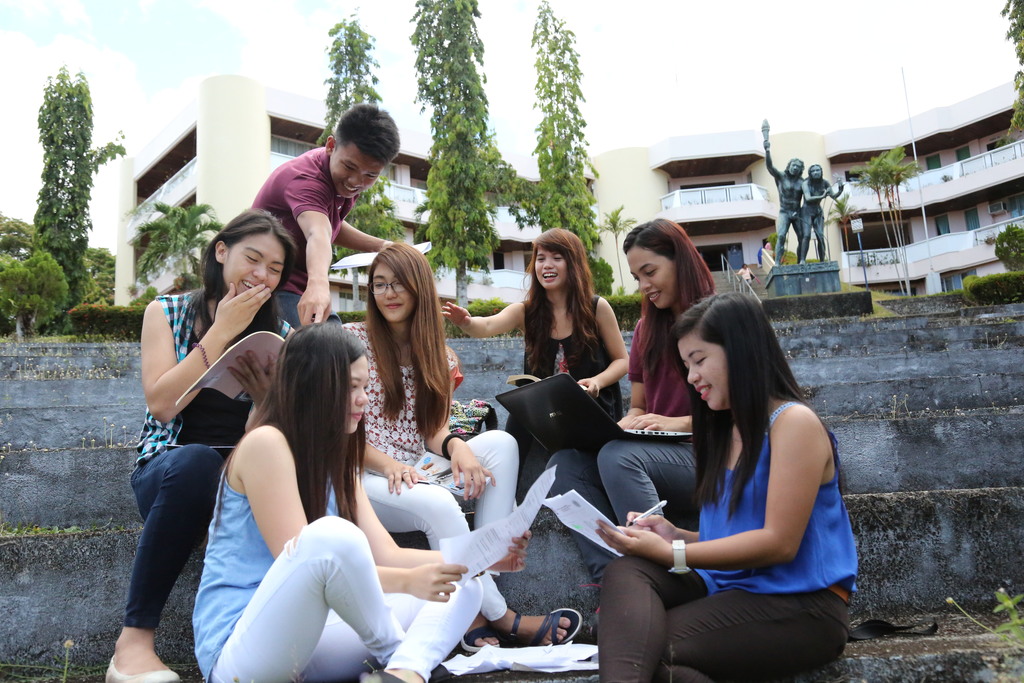
• Supreme Student Council
Know your leaders and college representatives.
• Student Media Organization
The Amaranth is the official student media organization of the Visayas State University. Currently, hailed as the best student publication in Region 8.
• Accredited Organizations
Involve in extra-curricular activities by joining an organization spanning from course-related, religious, greek-lettered, to interest groups.
• Sports, Recreation, and Arts
Join our varsity team (Team Phytons) or participate in our culture and arts activities and bring pride to the university.
• Student Bulletin
Be in the loop with university happenings and updates.
• Events
Mark your calendars. Here's what to expect for the rest of the year.
Starting last academic year, Visayas State University (VSU) introduced a one-stop shop enrollment system to make admission and enrollment more efficient and convenient for incoming Viscans. This setup was designed to reduce long queues, minimize confusion, and allow students to complete all necessary steps in one place.
This process brings together various enrollment services into a single venue. By doing so, VSU makes it easier for new students to settle everything without having to move from office to office.
For the incoming #ProudViscans of the Main Campus, enrollment will be held from June 23 to July 4, 2025 at the Center for Continuing Education (CCE) Building in the VSU Lower Campus.
To help you prepare, here is a step-by-step guide:
Step 1: Set an Online Appointment.
Before going to the enrollment site, students need to book an online appointment. This helps manage the number of students per day and keeps the process more organized. Only 250 slots are available per day. The appointment portal will open on June 16, 2025 (Monday) at 8:00 AM.
You can book your appointment here: https://cat2025.vsu.edu.ph/appointment. Below is your guide to set an appointment:
Step 2: Intake Session with a Guidance Counselor
Once on-site, students will attend a brief intake session (around 5–7 minutes) with a Guidance Counselor. This is a short orientation to introduce you to the services available for student support.
Additionally, students are required to bring one long white folder during your session.
Step 3: Submit Admission Requirements
Submit all original documents to the Admissions Office. Incomplete submissions will not be accepted. However, if the original PSA/NSO Birth Certificate is not yet available, it may be conditionally accepted if accompanied by a duly signed promissory note. You may check the list of required documents here: https://www.vsu.edu.ph/admission/college/enrollment-process
Applying for Dormitory Accommodation? If yes, you must pay 50% of the total dormitory fee for five months, depending on the rate of your selected dormitory or cottage.
Step 4: Pay Fees at the Cashier
Settle the following payments at the cashier:
Dormitory Application Fee (for dorm applicants)
ID Lanyard: Php 55.00
Step 5: Proceed to the Registrar’s Office
In this step, students will need to:
- Confirm the accuracy of personal profile and information.
- Have subjects encoded by the Registrar's staff.
- Receive an electronic copy of the Certificate of Registration (COR).
- Proceed to ID printing after the COR is issued.
Step 6: Photo ID
After receiving your COR, head to the ID station for photo capturing and printing. Ensure that you are in proper attire and presentable, as this ID will serve as your official student identification throughout your stay at the university.
Alternatively, you may prepare an e-copy of your ID photo with a white background, preferably in formal attire, to facilitate faster processing of their ID card.
Step 7: USSC Membership
All officially enrolled students are required to register for the University Supreme Student Council (USSC) – Baybay. As mandated by Article 5, Section 4 of the USSC Constitution and By-Laws, all officially enrolled students are required to become members of the University Supreme Student Council (USSC) - Baybay and pay Php 50.00 per semester, totaling Php 100.00 per academic year.
Students are also advised to bring your mobile phones to facilitate the online registration process for USSC membership.
Step 8: Submit Customer Feedback
After completing the enrollment process, students are encouraged to provide feedback on their experience. This helps improve the quality of services offered.
We’re looking forward to welcoming you to the very scenic university! Please come prepared, follow the instructions carefully, and do not forget to check the official VSU Facebook page and website for any updates or announcements.
We hope your enrollment goes smoothly and see you soon, future #ProudViscans!
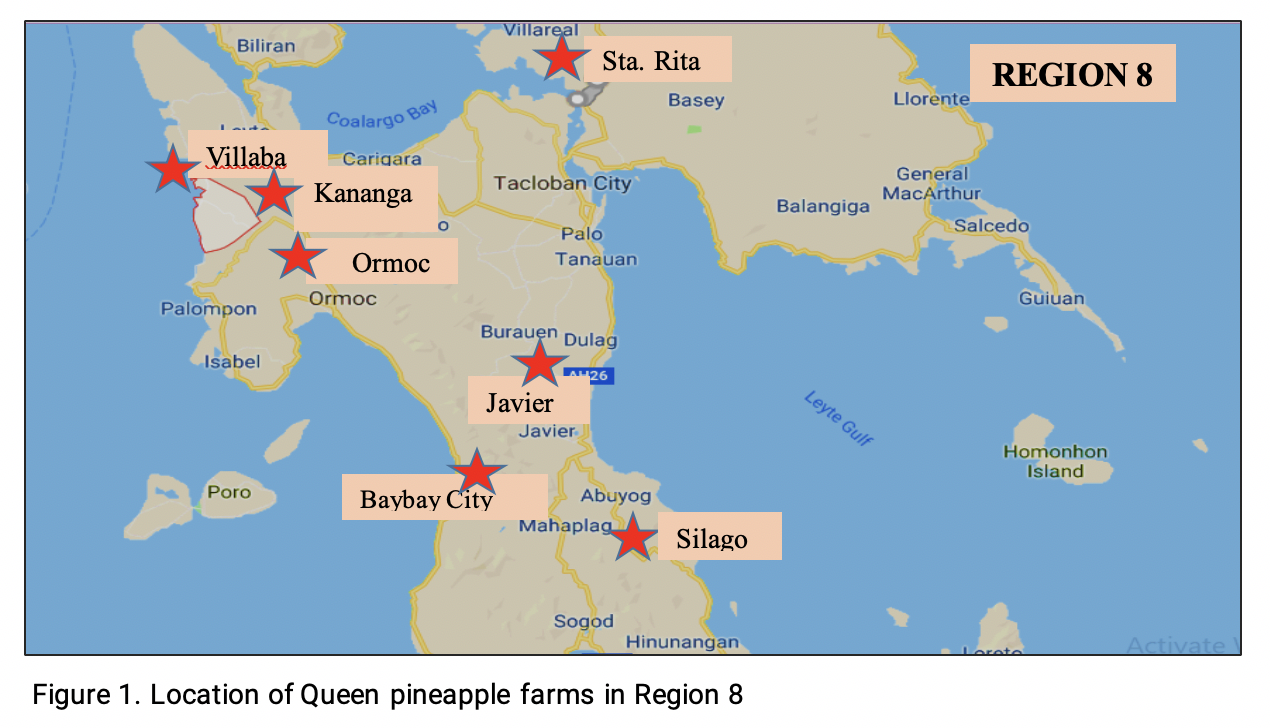 In Region VIII, Queen Pineapple populations including the newly established ones were documented as to size and location. As surveyed, Queen pineapples are grown in Baybay City, Javier, Kananga, Ormoc City and Villaba in Leyte, Sta. Rita in Samar and Silago in Southern Leyte, with a total area of 229.78 hectares.
In Region VIII, Queen Pineapple populations including the newly established ones were documented as to size and location. As surveyed, Queen pineapples are grown in Baybay City, Javier, Kananga, Ormoc City and Villaba in Leyte, Sta. Rita in Samar and Silago in Southern Leyte, with a total area of 229.78 hectares.
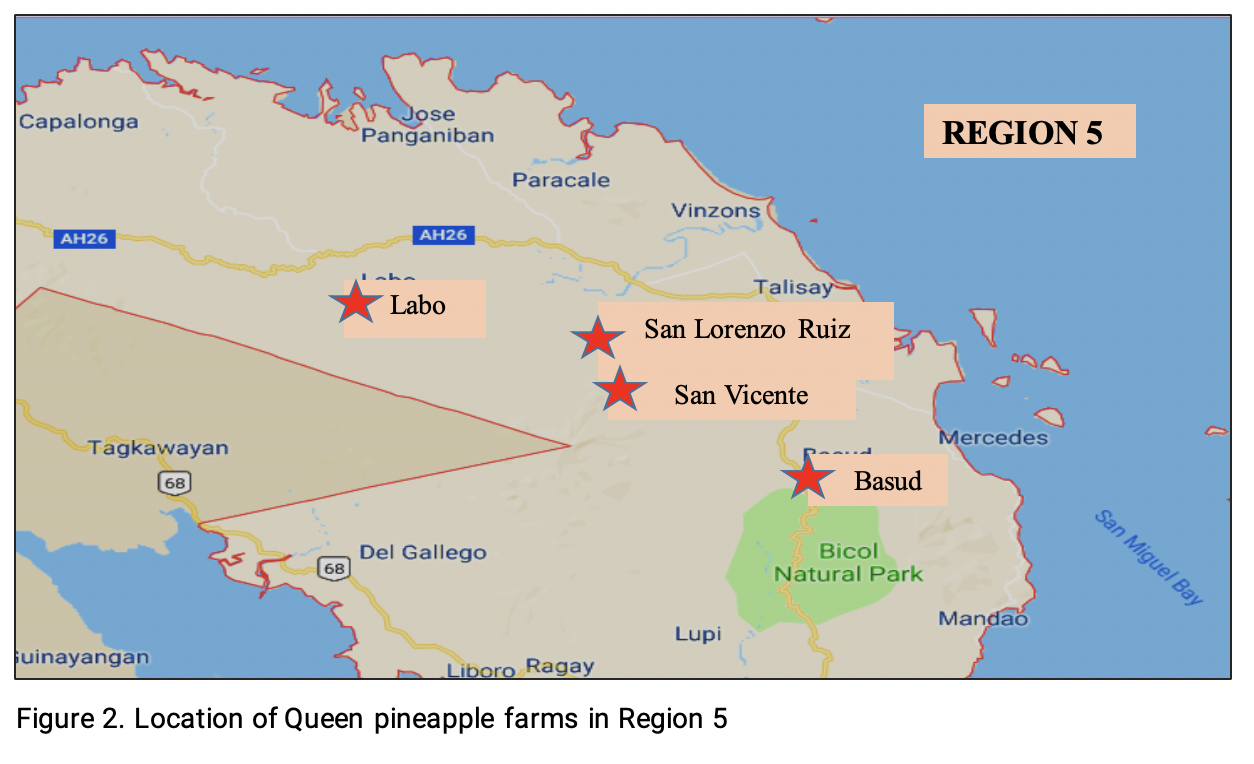
In Luzon, Queen Pineapple is mainly grown in the Provinces of Camarines Norte. A total of 2,525 hectares of the province is planted to pineapple translated to 82% of total pineapple area in Municipality of Basud, Labo, San Lorenzo Ruiz and San Vicente, Camarines Norte.
1. Use of Potential Antagonists
• Trichoderma sp. (fig.1)
• Penicillum sp. (Isolate1) (fig.2)
• Penicillum sp. (Isolate2) (fig.3)
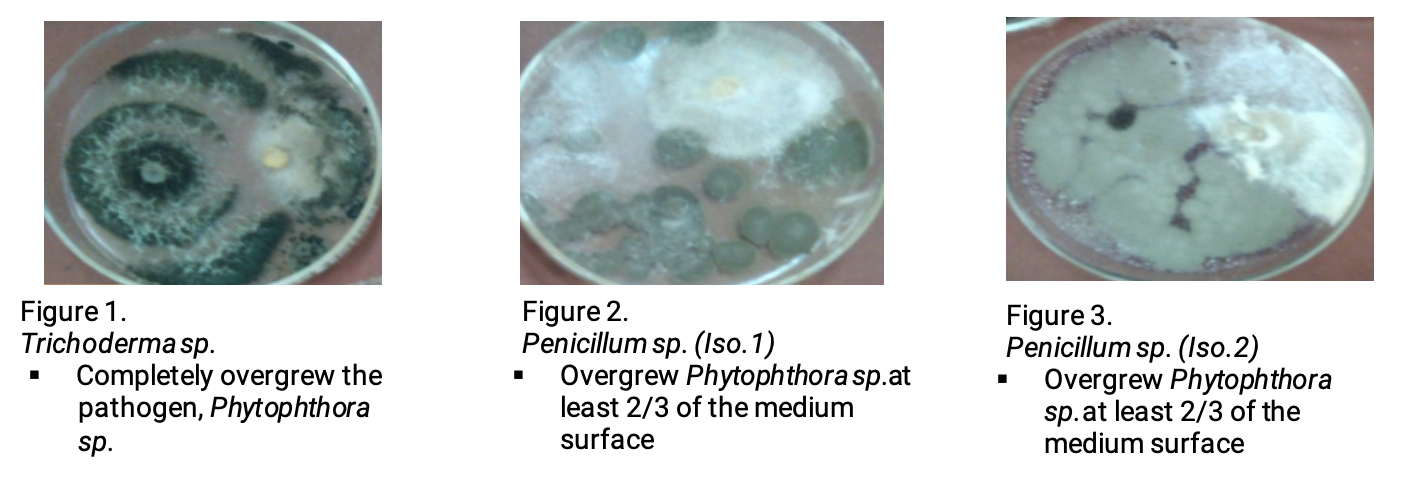
2. Use of Plant Extracts/Plant-Based Solution
Plant extracts that inhibits the germination of spores of Colletotrichum sp. were:
• Mayana, Coleus scutellarioides (fig.4)
• Panyawan, Tinospora rumphii (fig.5)
• Tigbaw, Callicarpa cana (fig.6)
• Asyang, Mikania cordata (fig.7)
• Ginger, Zingiber officinale (fig.8)
• Bio-Path (fig.9)
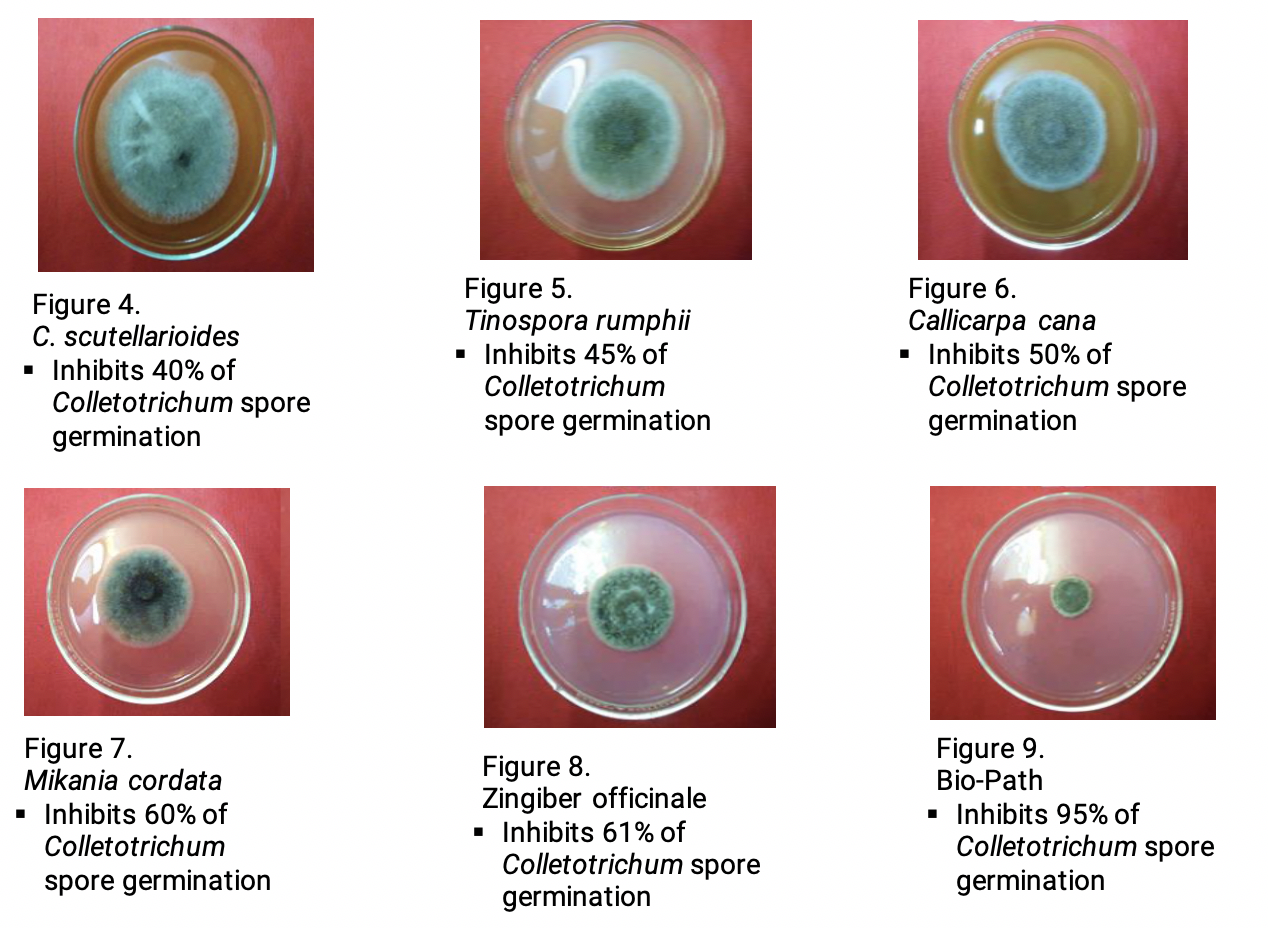
3. Use of Wood Vinegar
Wood vinegar is a liquid generated from the gas and combustion of fresh wood burning in airless conditions.
Effective wood vinegar plant sources found to affect the development of Colletotrichum sp at 7% (fig.10) and 10%(fig.11) concentration were:
• Tigbaw, Callicarpa cana
• Bamboo, Bambusa vulgaris


Figure 1. H. pseudococcina parasitizing on adult PPMB
1. Parasitoids
Encyrtid Parasitoid, Hambletonia pseudococcina (Compere)
Order: Hymenoptera
Family: Encyrtidae
Description: A very small parasitoid with clubbed-like antennae that can be parasitized up to 8 adult PPMBs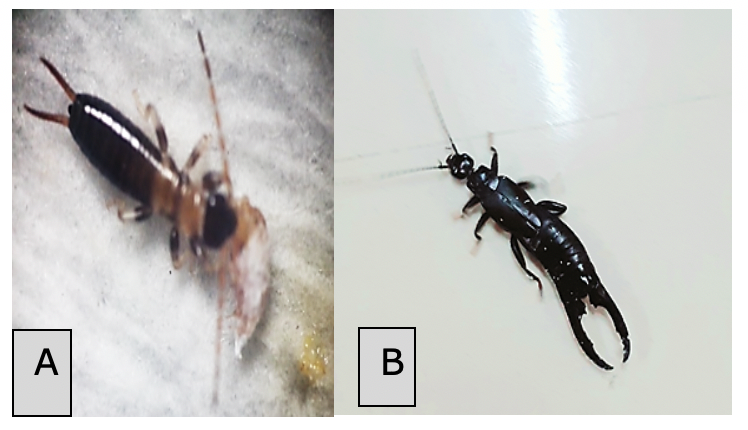
Figure 2. A) Nymphal and (B) adult stages of predatory earwig
2. Predators
- Predatory black earwig, Chelisoches morio
Order: Dermaptera
Family: Chelisochidae
Description: Has four nymphal instars that can reach up to 120 days prior from hatching to mortality and can consume 1-2 adult PPMB and up to 100 individuals of PPMB crawlers per day
Figure 3. Cryptolaemus montrouzieri feeding on adult PPMB
- Predatory coccinellid beetle, Cryptolaemus montrouzieri
Order: Coleoptera
Family: Coccinellidae
Description: A voracious predator with a long history in biological control against mealybugs that could potentially consume up to 20 individuals of PPMB crawlers and 1 PPMB adult per day.
3. Entomopathogenic Fungi (EPF)
EPFs are microorganisms that specifically infect and often kills insects and other arthropods. EPFs are eco-friendly and good substitute for chemicals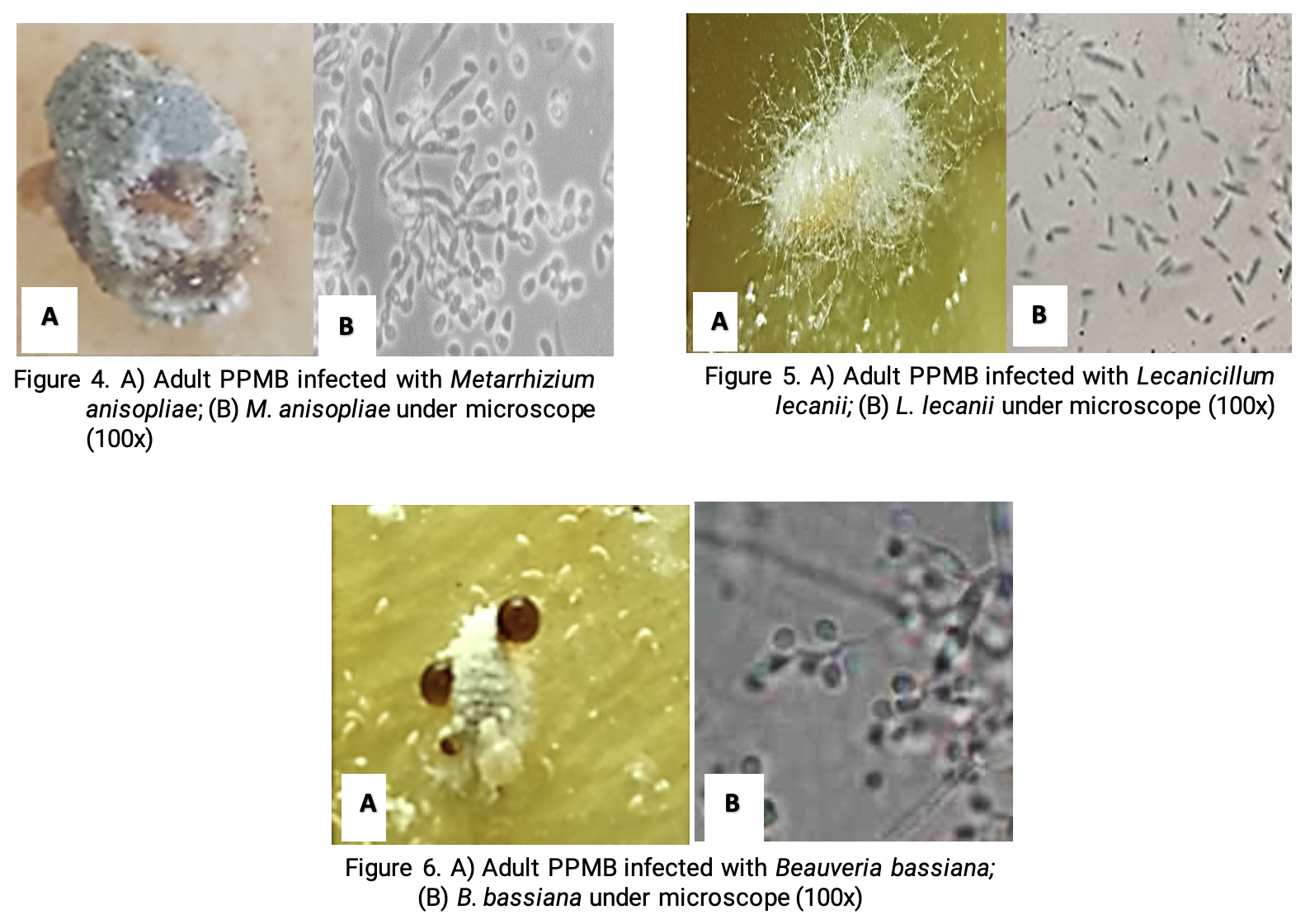
Three (3) isolates of EPFs against PPMB:
• Metarrhizium anisopliae (fig.4)
• Lecanicillum lecanii (fig.5)
• Beauveria bassiana (fig.6)
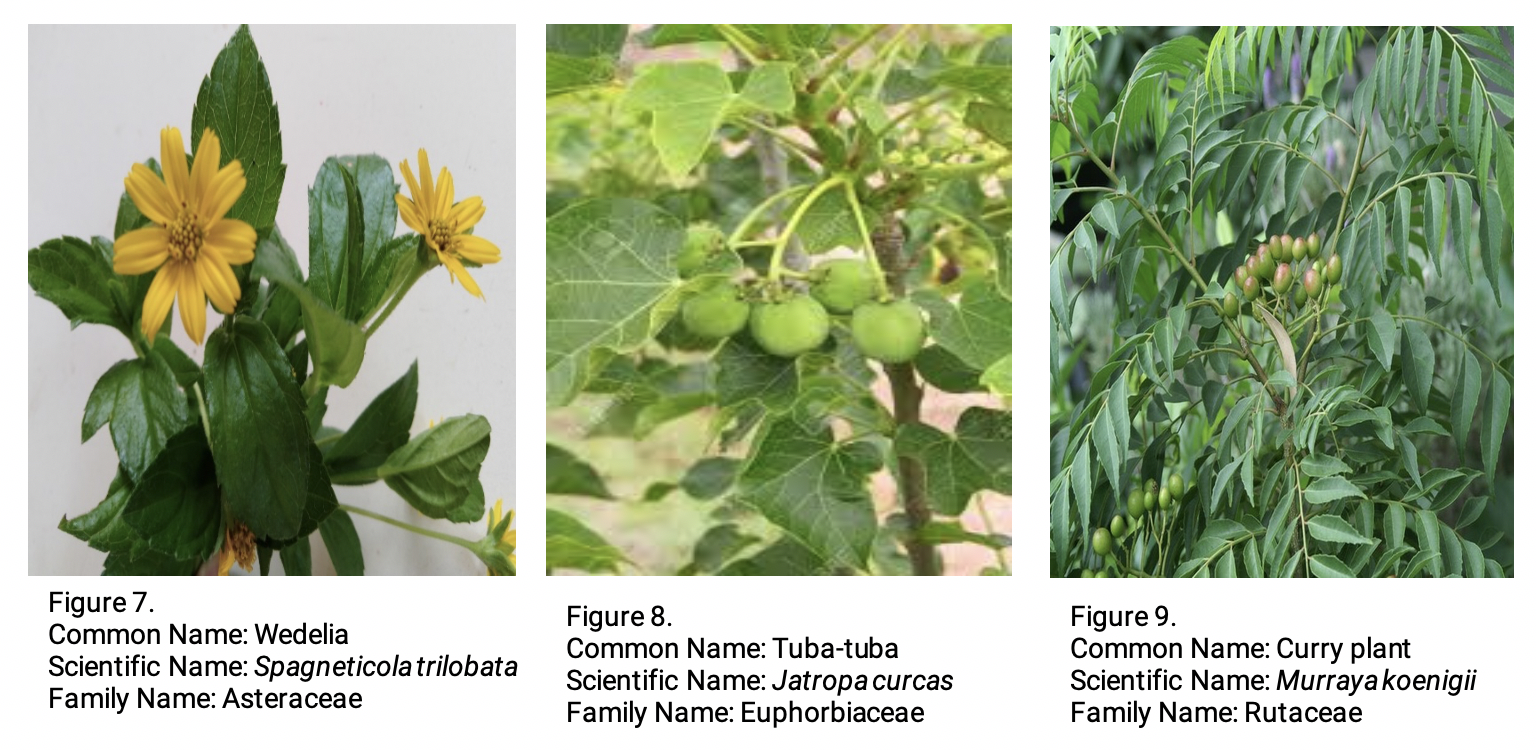
4. Botanical Insecticides
Botanical insecticides are naturally occurring chemicals extracted from plants or minerals to control or minimize insect pest population.
Botanical insecticides against PPMB includes:
• Jatropa curcas (fig.13)
• Murraya koenigii (fig.14)
• Spagneticola trilobata (fig.15)
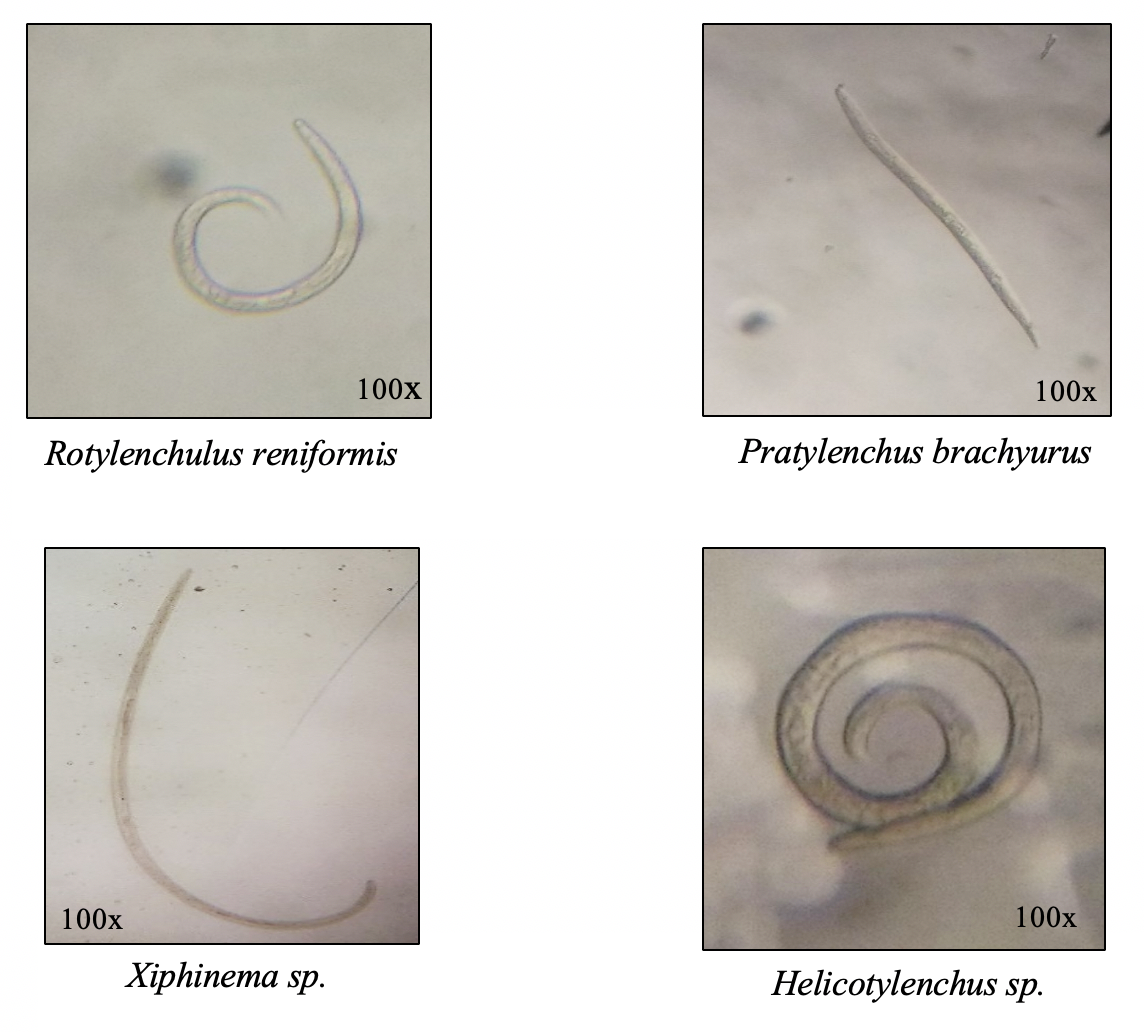 Plant-parasitic nematodes are pests of agricultural crops and cause crop yield reduce when the roots are damaged. Pineapple is extremely sensitive to root feeding nematodes. Four genera of plant parasitic nematodes were found to be associated with Queen pineapple such as Rotylenchulus reniformis, Pratylenchus brachyurus, Xiphinema sp. and Helicotylenchus sp. as soil samples were collected and isolated.
Plant-parasitic nematodes are pests of agricultural crops and cause crop yield reduce when the roots are damaged. Pineapple is extremely sensitive to root feeding nematodes. Four genera of plant parasitic nematodes were found to be associated with Queen pineapple such as Rotylenchulus reniformis, Pratylenchus brachyurus, Xiphinema sp. and Helicotylenchus sp. as soil samples were collected and isolated.
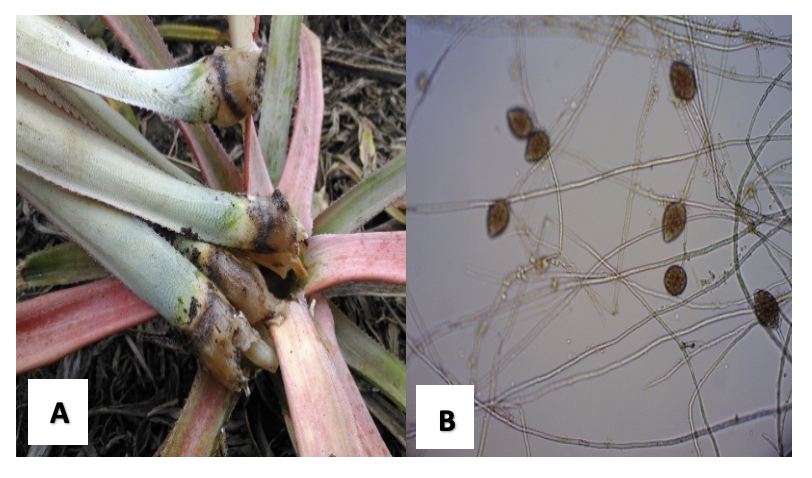
Figure 1. A) Queen pineapple with Heart rot disease and B) Phytophthora cinnamomi under a microscope (100x)
A. Heart rot and root rot
• Causal Organism: Phytophthora cinnamomi
• Symptoms: soft rotting of the basal white tissues of the youngest leaves at the heart of the apical meristem; necrosis (Green and Nelson, 2015; Ceniza et al, 2018)
• Economic Importance: most destructive soil-borne pathogen with 20-30% prevalence (Shen et al., 2013)
• Distribution: As surveyed, it was observed in Ormoc City, Leyte and Silago, Southern Leyte
a. Management Options: Integration of regulatory, cultural, chemical, and biological practices (Green and Nelson, 2015); Use of antagonists Trichoderma and Penicillium sp. (Oclarit, 2018)
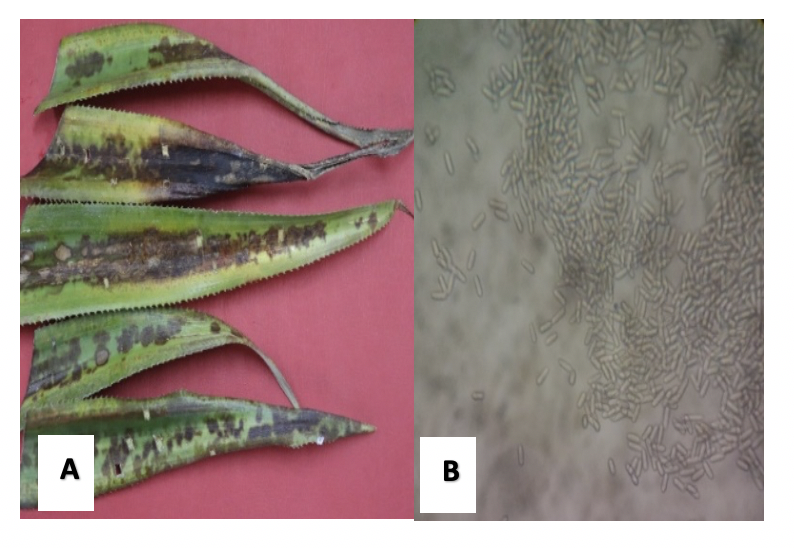
Figure 2. A) Queen pineapple leaves with anthracnose disease, B) Colletotrichum gloeosporioides under microscope (100x)
B. Anthracnose
• Causal Organism: Colletotrichum gloeosporioides
• Symptoms: dark, water-soaked lesions on leaves (Kumar, 2014; Ceniza et al, 2018)
• Economic importance: wide host range: coconut, mango, banana, avocado, papaya, etc. (Nelson 2008)
• Distribution: As surveyed, it was observed in Baybay City, Javier, Leyte, and Silago, Southern Leyte
a. Management Options: Carry out regular weeding and timely pruning of the infected plant parts; Plant resistant varieties (Waller, 1992); use of wood vinegar (Torres, 2018); use of plant extracts (Payot, 2018)
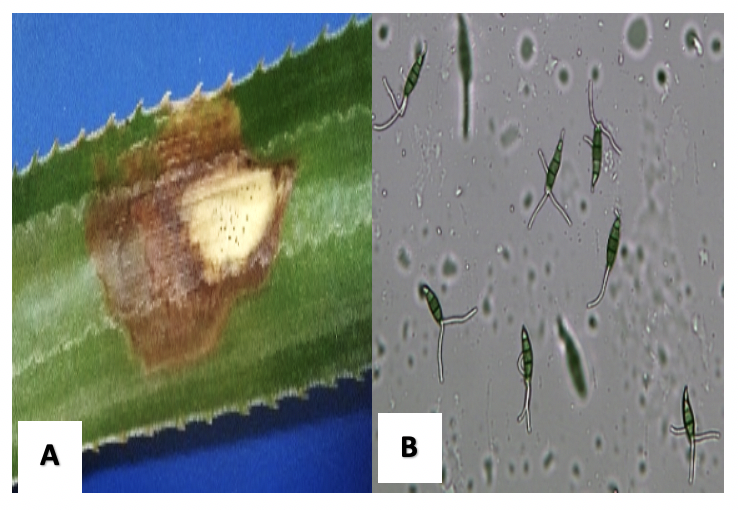 Figure 3. A) Queen pineapple leaves with leaf blotch, B) Pestalotia sp. under a microscope (100x)
Figure 3. A) Queen pineapple leaves with leaf blotch, B) Pestalotia sp. under a microscope (100x)
C. Leaf Blotch
• Causal Organism: Pestalotia
• Symptoms: chlorotic, water-soaked flecksthat enlarge to become dry, yellow, then red-brown, blocky to oval lesions (IPCM, 2013; Alegre et al, 2018)
• Economic Importance: Affects photosynthesis of the plant (Alegre et al, 2018)
• Distribution: It was observed pineapple fields in the Municipality of Basud and San Vicente, Camarines Norte (Alegre et al, 2018)
a. Management Options: Crop rotation, proper crop debris management, and fungicide treatments (IPCM, 2013)
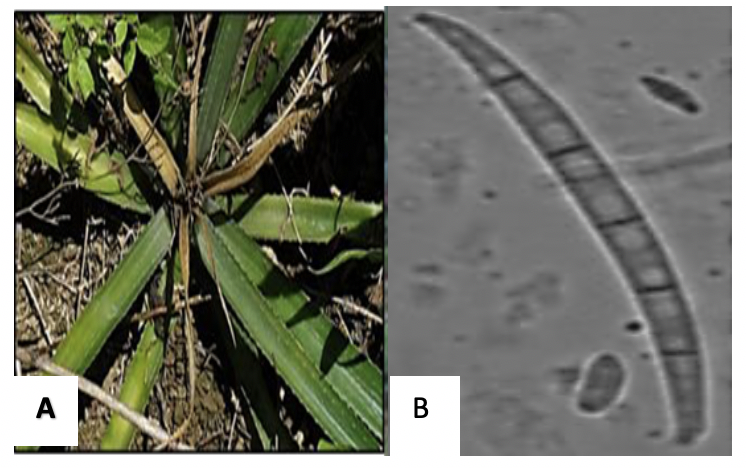
Figure 4. A) Queen Pineapple with blight disease; B) Fusarium sp. under microscope (400x)
D. QP Blight
• Causal Organism: Fusarium
• Symptoms: Drying of leaves, noticeable loss of vigor and severe injury to the vascular level (Alegre et al, 2018)
• Economic Importance: Death of plants (Alegre et al, 2018)
• Distribution: It was observed in San Lorenzo Ruiz, San Vicente, Basud, Bibirao and Calasgasan, Camarines Norte (Alegre et al, 2018)
a. Management Options: Crop rotation, proper crop debris management, and fungicide treatments (IPCM, 2013)
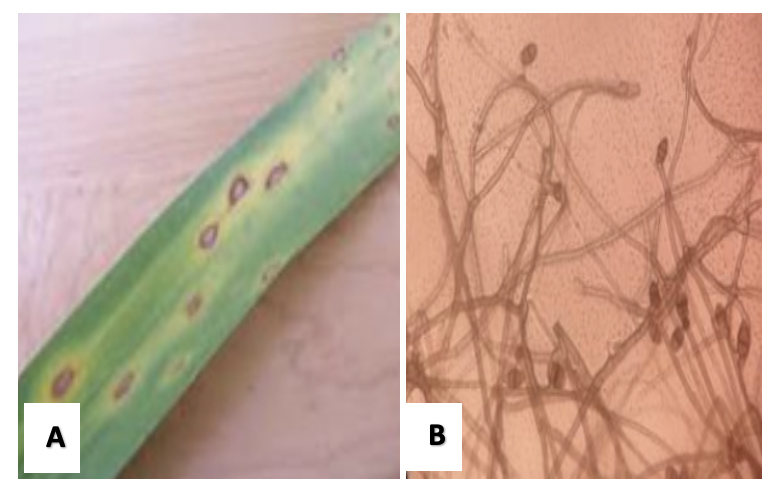 Figure 5. A) Queen pineapple with leaf spot; B) Curvularia sp. under a microscope (100x)
Figure 5. A) Queen pineapple with leaf spot; B) Curvularia sp. under a microscope (100x)
E. QP Leaf Spot
• Causal Organism: Curvularia
• Symptoms: Yellow, brown lesions which eventually turns dark on QP leaves (Alegre et al, 2018)
• Economic Importance: Affects photosynthesis of the plant if severe could result to death of plant (Alegre et al, 2018)
• Distribution: It was observed in San Lorenzo Ruiz, San Vicente, Basud, Bibirao and Calasgasan, Camarines Norte (Alegre et al, 2018)
a. Management Options: Crop rotation, proper crop debris management, and fungicide treatments (IPCM, 2013)
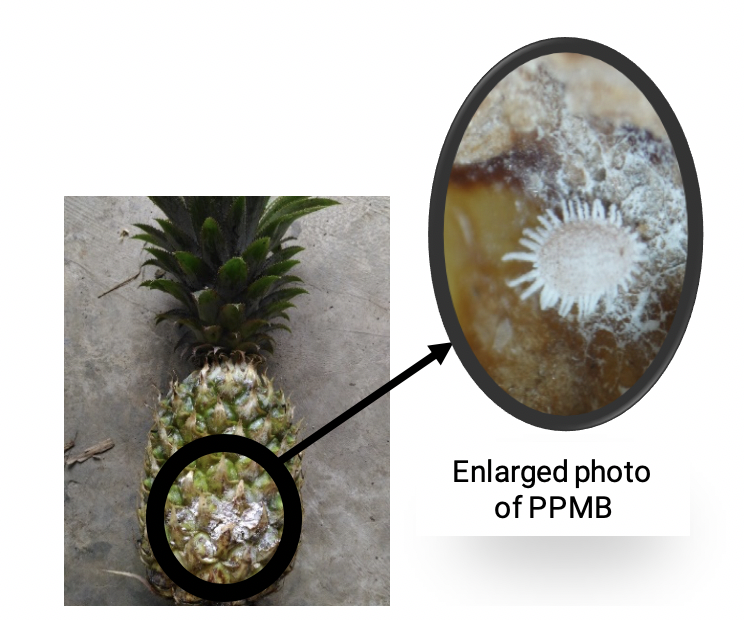
Figure 1. Queen Pineapple fruit infested with PPMB
Description
- Pink pineapple mealybug, Dysmicoccus brevipes Cockerell (PPMB), is one of the major pests of pineapple [Ananas comosus (L.) Merrill].
- Belongs to Family Pseudococcidae and described as cottony, small, oval and soft-bodied sucking insect (Joy, et al., 2013).
- Feeds on the fruits, roots, stem, and leaves of the plant (Ceniza et al, 2018)
- Dispersed by ants (Joy et, 2013) because PPMB secreteS sweet and sticky liquid called honeydew as a by-product of its feeding (Rohrbach and Johnson, 2003).
- Distribution: Baybay City, Javier, Ormoc City, Villaba in Leyte; Silago in Southern Leyte; San Lorenzo in Camarines Norte (QP Project 4)
Faculty of Agriculture and Food Science
Department of Agricultural Education and Extension
Department of Development Communication
Department of Food Science and Technology
Department of Plant Breeding and Genetics
Faculty of Arts and Sciences
Department of Biological Sciences
Department of Arts,Languages and Literature
Department of Philosophy and Social Sciences
Department of Pure & Applied Chemistry
Faculty of Teacher Education
Department of Secondary Education
Faculty of Engineering
Department of Agricultural and Biosystems Engineering
Faculty of Forestry and Environmental Sciences
Institute for Tropical Ecology and Environmental Management
Faculty of Management and Economics
Department of Business Management
Institute of Strategic Research and Development Studies
Department of Pure & Applied Chemistry
GRADUATE FACULTY
- Teaching and Research Faculty
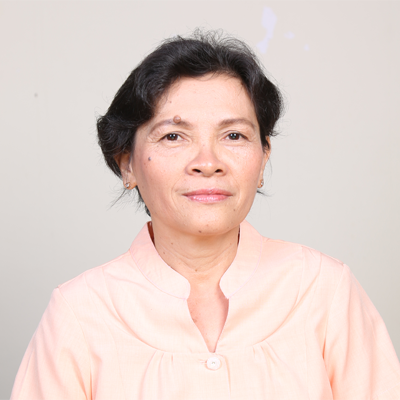 |
Elizabeth S. QuevedoAssociate Professor V |
Highest Degree Attained
|
||
Specialization |
||
Research Interest
|
||
Role
|
||
Status of Appointment
|
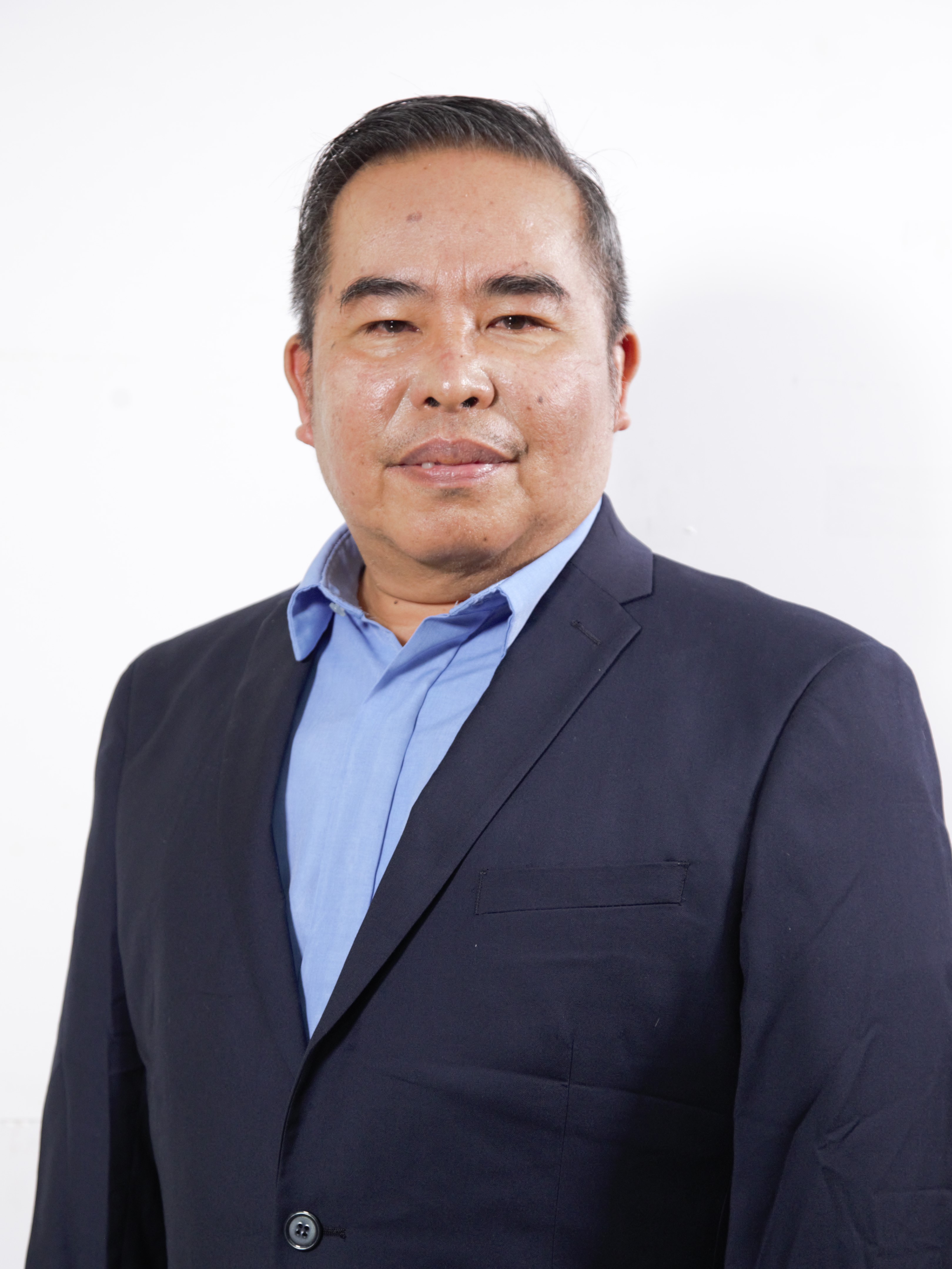 |
Felix M. SalasProfessor VI |
Highest Degree Attained
|
||
Specialization
|
||
Research Interest
|
||
Role
|
||
Status of Appointment
|
 |
Edgardo E. TulinUniversity President |
Highest Degree Attained
|
||
Specialization
|
||
Research Interest
|
||
Role
|
||
Status of Appointment
|
 |
James A. PatindolAssociate Professor V |
Highest Degree Attained
|
||
Specialization
|
||
Research Interest
|
||
Role
|
||
Status of Appointment
|
- Teaching Faculty
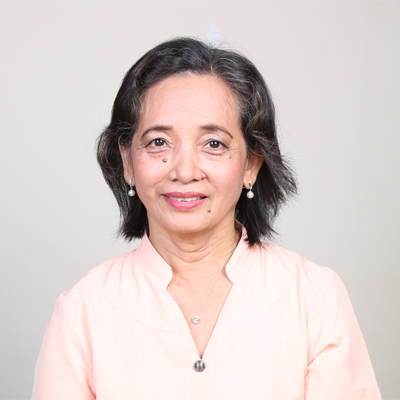 |
Ma. Theresa P. LoretoAssociate Professor V |
Highest Degree Attained
|
||
Specialization
|
||
Research Interest
|
||
Role
|
||
Status of Appointment
|
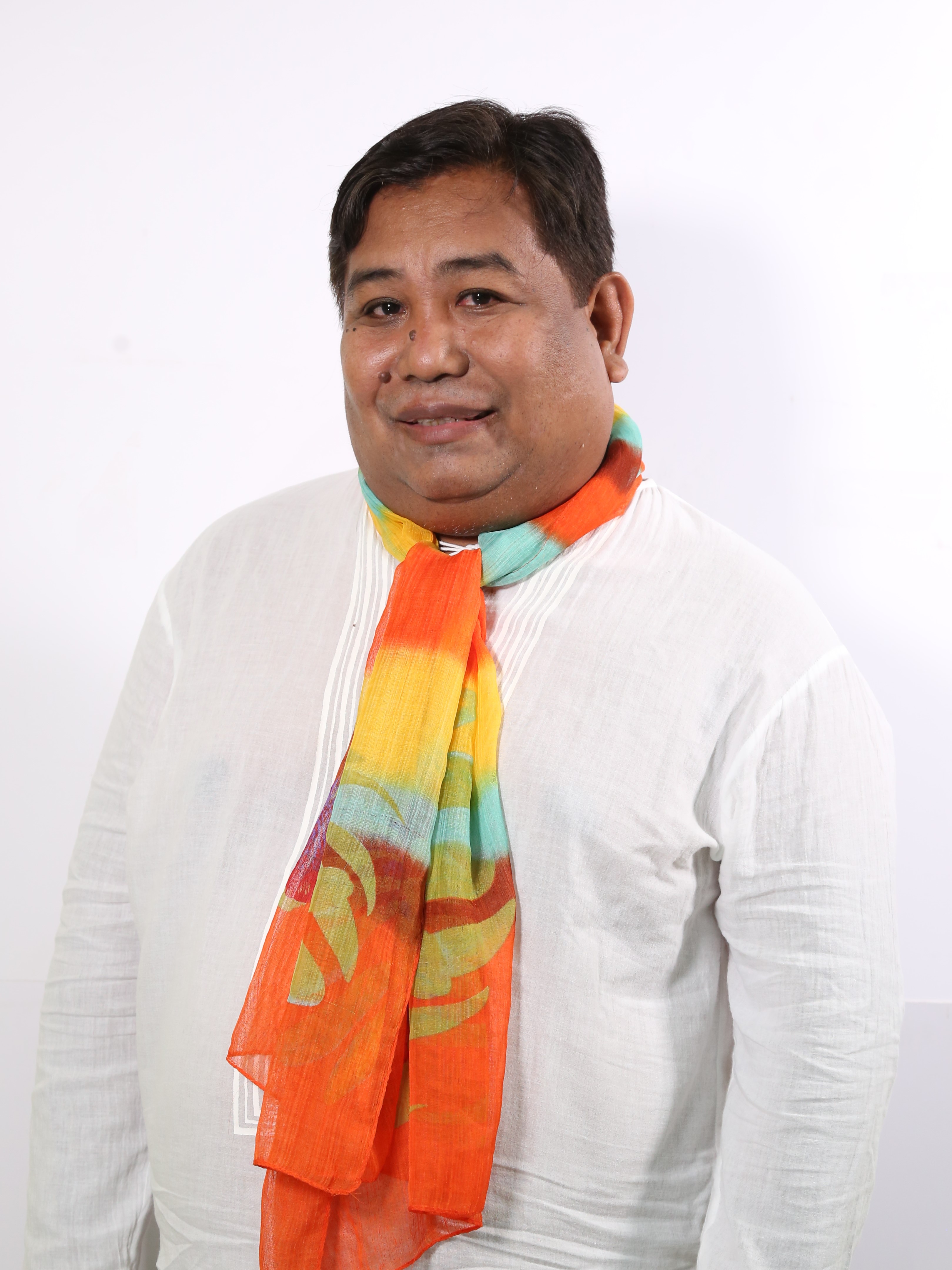 |
Allan A. RamalAssociate Professor V |
Highest Degree Attained
|
||
Specialization |
||
Research Interest
|
||
Role
|
||
Status of Appointment
|
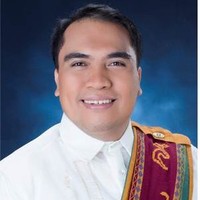 |
Genesis AlbaricoInstructor II |
Highest Degree Attained
|
||
Specialization |
||
Research InterestNatural products research and Or anicsynthesis |
||
Role
|
||
Status of Appointment
|
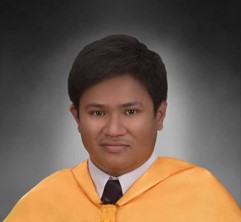 |
Mark Ryan R. TripoliInstructor I |
Highest Degree Attained
|
||
Specialization |
||
Research Interest
|
||
Role
|
||
Status of Appointment
|


